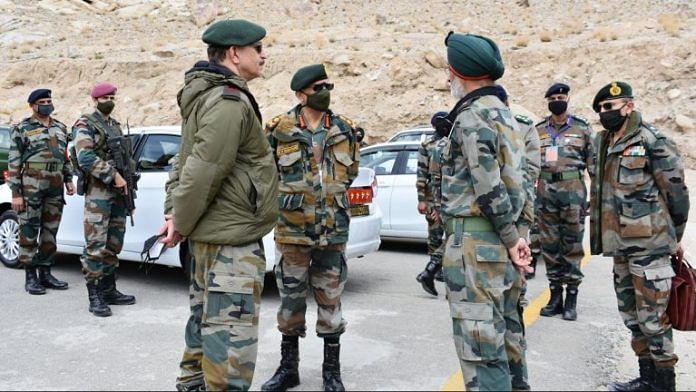New Delhi: The Indian military is bringing a series of key changes, including in the Order of Battle (ORBAT), with the strategy being punitive deterrence against Pakistan and credible deterrence against China, ThePrint has learnt.
This strategy, which called for integrated formations rather than just corps-level response, forms the foundation of the Indian military’s re-balance from the western borders with Pakistan to the northern and eastern borders with China.
Government sources told ThePrint that the overall strategy does not involve the military alone but also diplomacy and economics.
“From a military point of view, the western theatre has always been the focus area. Our strategy there has been that of punitive deterrence. This means that India has overwhelmingly higher military power for punitive action,” a source said.
Explaining the nuance of the strategy against China, the source said the aim is credible deterrence.
“Under credible deterrence, the opposite side should know that India has the ability for a counter operation and to inflict damage. China sees itself equal to the US in terms of military power. However, it has realised that while militarily it might be bigger, India won’t budge and can actually hit back. This affects the image that they want to portray internationally. This is called credible deterrence,” the source said, refusing to go into the key changes planned and set in motion.
Sources gave the example of the last year’s August 29/30 operation by the Indian forces when they outflanked the Chinese and occupied the heights in the southern banks of Pangong Tso, much to the discomfort of the Chinese.
Sources explained that this strategy is for along the Line of Actual Control (LAC) with China and not just Ladakh which comes under the Northern sector. This means that the strategy will extend to the Central and Eastern sectors too.
The Army chief Gen M M Naravane had in January this year said the force was “re-balancing” its deployment and strategy along the western, northern and northeastern borders to deal with any kind of threat that might emerge — be it from Pakistan or China.
The re-balance strategy came following an internal study conducted by the Army on how to prepare for the threat from China and Pakistan.
ThePrint had on 12 April reported that a summer strategy has already been put in place in Eastern Ladakh and also implemented key changes in the ORBAT.
Also read: Army chief Naravane visits eastern Ladakh, Siachen, reviews operational preparedness
More troops along the LAC than before
There is a higher concentration of troops in Ladakh with the focus being on Reserves and enough troops in the front to counter any possible Chinese move as tensions remain between the two countries.
Sources said the same strategy has been implemented all along the LAC, which meant there are a higher number of troops in each location with new counter operational strategies in place.
However, they made it clear that that more troops does not mean sitting all along the LAC like the Line of Control with Pakistan, but having enough troops to counter any aggression and for its own counter operations.
This meant the Army retained a higher number of troops and equipment in Ladakh, besides the 3 Division, in-charge of the LAC there, and the 14 Corps Reserve.
This includes some of the formations pumped in last year following the tensions with China, besides new elements brought in for summer deployment.
The same strategy is being followed all along the LAC as the force maintains a high state of operational alert.
Also read: Soldiers sit tight in Ladakh amid India’s Covid crisis, but construction activity continues
Focus on integrated battle and not just Corps level response
Under the changes in ORBAT, while India earlier had three Strike Corps focused against Pakistan, it now has two. And instead of just one Strike Corps against China, it has two now.
“The focus is not just on corps-level response to an aggression but also a more integrated response,” said a source.
This means not just the Integrated Battle Groups (IBGs), the brainchild of Chief of Defence Staff Gen Bipin Rawat when he was the Army chief, but also a joint response from the three Services — Army, Navy and Air Force.
Incidentally, the Army had in October 2019 put into action its concept of IBGS for the first time.
The IBGs were carved out of the Panagarh-based 17 Corps’ (Mountain Strike Corps) 59 Mountain Division.
The plan was that this would be a study case and the IBGs would be rolled out after fine-tuning.
Each IBG would be based on specific operational requirements considering the topography as well as threat perceptions.
Gen Naravane had in May last year said the IBGs would be operational “soon”. However, the process got hit because of the pandemic and the tensions that broke along the LAC in eastern Ladakh.
Also read: Indian Army helps evacuate civilians after volcano erupts in Congo



